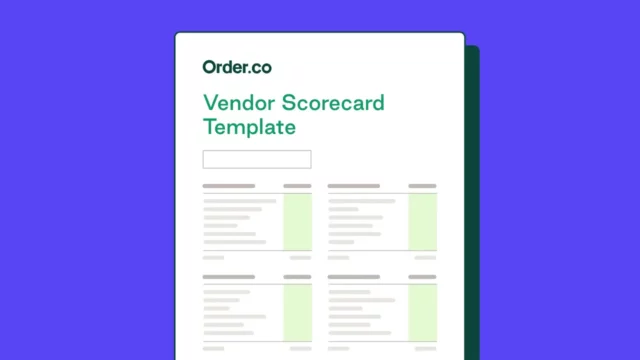A Complete Vendor Lifecycle Playbook: Onboarding, Performance, and Offboarding

A Complete Vendor Lifecycle Playbook: Onboarding, Performance, and Offboarding
Managing vendors can feel like a chaotic, full-time job. Between scattered invoices, inconsistent pricing, and employees buying from unapproved suppliers, it’s easy to lose track of who you’re working with and how much you’re spending. Without a structured process, you expose your business to unnecessary risks, operational friction, and costly inefficiencies that drain your budget.
Effective vendor lifecycle management replaces this chaos with control. It’s a strategic approach that covers every interaction with a supplier, from the moment you identify a need to the day you part ways. This comprehensive playbook breaks the process down into three critical phases: onboarding, performance management, and offboarding, giving you a clear roadmap to build stronger supplier relationships and unlock greater value.
Download the free tool: Vendor Scorecard Template
What is vendor lifecycle management?
Vendor lifecycle management is the end-to-end process of strategically managing your company’s relationships with its suppliers. It encompasses every stage of the partnership, including initial discovery and selection, onboarding and integration, ongoing performance monitoring, and eventual offboarding or contract termination.
A proactive vendor management strategy is critical for financial health and operational stability. It helps businesses mitigate supply chain risks, enforce compliance, control costs, and ensure consistent quality. Companies that neglect this process often face the consequences of disorganized, transactional buying, which leads to rogue spending, duplicate payments, and missed opportunities for cost savings. By implementing a formal lifecycle playbook, you transform vendor relationships from a reactive administrative burden into a strategic asset.
Phase 1: Creating a strategic supplier onboarding checklist
A strategic supplier onboarding checklist is your first line of defense against future problems. This process ensures new vendors are properly vetted, integrated into your systems, and aligned with your company's compliance and financial standards before any purchases are made. A rushed or incomplete onboarding process is a primary source of future invoice discrepancies, payment delays, and compliance issues.
Step 1: Vendor discovery and qualification
Finding the right long-term partner goes beyond simply sourcing the lowest price. The qualification stage is about ensuring a vendor can meet your standards for quality, reliability, and financial stability. This involves thorough due diligence to confirm they are a good fit for your operational needs and company values.
Your qualification process should include:
- Assessing financial stability (for large contracts): Review credit reports or financial statements to ensure the vendor is a viable, long-term partner.
- Checking references: Speak with other customers to validate the vendor’s performance, reliability, and customer service.
- Verifying capabilities: Confirm that the supplier has the capacity and expertise to meet your volume and quality requirements.
- Aligning on compliance: Ensure the vendor can adhere to your industry-specific regulatory and security standards.
Effective category management during this stage helps you identify top-performing suppliers in specific spend areas, building a resilient and high-value supply base.
Step 2: Information and document collection
Once a vendor is qualified, the next step is to collect all necessary legal, financial, and compliance documentation. Managing this process over insecure email chains creates risk and makes it difficult to track down information later. A centralized system is essential for securely gathering and storing these critical files.
Key documents to collect include:
- W-9 or W-8BEN forms for tax purposes
- Certificates of insurance (COI) to verify coverage
- Signed contracts, master service agreements (MSAs), or statements of work (SOWs)
- Banking information for electronic payments (ACH/wire)
- Nondisclosure agreements (NDAs) to protect sensitive information
Step 3: System integration and setup
With the paperwork complete, it’s time to integrate the vendor into your financial and operational systems. This crucial step ensures that every future transaction is tracked, coded, and processed correctly from day one. Accurate setup minimizes manual work for your accounts payable team and provides clear data for financial reporting.
System integration involves:
- Creating a vendor profile in your accounting or procurement platform.
- Assigning default general ledger (GL) codes.
- Establishing payment terms and methods.
- Setting up user permissions and purchasing controls.
Step 4: Communication and expectation setting
The final step of onboarding is to align on processes and expectations. Clear communication prevents the misunderstandings that lead to payment delays and operational friction. This is your opportunity to define how your teams will work together.
Key areas to cover include:
- Purchase order process: How will you submit orders? Who are the key contacts?
- Invoicing requirements: What information must be included on every invoice to ensure timely payment?
- Communication channels: Who should be contacted for issues related to orders, payments, or service?
Phase 2: Managing and optimizing vendor performance
Ongoing vendor performance management involves continuously monitoring, measuring, and communicating with suppliers to ensure they meet contractual obligations and deliver sustained value. This proactive approach allows you to identify and address issues before they disrupt your operations, strengthen partnerships with high-performing vendors, and make data-driven decisions about contract renewals.
Step 1: Establishing key performance indicators (KPIs)
You can’t manage what you don’t measure. Establishing clear, measurable KPIs is the foundation of an effective performance management program. These metrics should align with your business goals and the specific services or goods the vendor provides.
Common vendor KPIs include:
- On-time delivery rate: The percentage of orders delivered by the agreed-upon date.
- Order accuracy: The percentage of orders that are complete and correct.
- Quality and defect rate: The number of products or services that fail to meet quality standards.
- Price competitiveness: How the vendor’s pricing compares to market rates or initial quotes.
- Invoice accuracy: The percentage of invoices submitted without errors.
- Responsiveness: The time it takes for a vendor to respond to inquiries or resolve issues.
Tracking these metrics gives you objective data to assess performance and improve your overall spend efficiency.
Step 2: Conducting regular performance reviews
Data alone isn’t enough; it needs to drive conversation and action. Regular performance reviews—typically quarterly or annually—create a forum for open dialogue with your key suppliers. These meetings are an opportunity to discuss KPI results, address challenges, and collaboratively identify areas for improvement. Using a vendor scorecard can help structure these conversations and track progress over time.
Step 3: Managing contracts and renewals
Without a system to track contract terms, it’s easy to get locked into auto-renewals with underperforming suppliers or miss opportunities to negotiate better terms. Proactive contract management involves monitoring key dates, terms, and conditions to ensure you always get the best value. This is especially important for managing tail spend management, where dozens of small contracts can auto-renew without proper oversight.
Step 4: Centralizing communication and order management
Managing vendor relationships through scattered emails and phone calls is a recipe for confusion. A centralized platform for communication and order management ensures all interactions are documented and visible. When you use a single system for purchase order processing, you create a transparent audit trail that simplifies issue resolution and holds both parties accountable.
Phase 3: Executing a seamless vendor offboarding process
A formal vendor offboarding process is a structured procedure for terminating a supplier relationship smoothly and securely. Whether you’re ending a contract due to poor performance, shifting business needs, or consolidating suppliers, a clear exit strategy is essential to mitigate risk, protect sensitive data, and ensure a clean financial break.
Step 1: Finalizing all transactions and payments
The first step is to ensure all financial obligations are met. This involves a final reconciliation of accounts to confirm that all outstanding invoices have been paid, all goods have been received, and any pending returns or credits have been processed. A clean financial slate prevents future disputes and ensures accurate bookkeeping.
Step 2: Revoking system and data access
One of the biggest risks in vendor offboarding is orphaned access. Former vendors who still have access to your internal systems—whether it’s a software portal, a shared drive, or a physical location—pose a significant security threat. Immediately upon termination, you must revoke all digital and physical access credentials to protect your company’s sensitive information.
Step 3: Archiving records and contracts
While access should be revoked, all relevant documentation must be securely archived. Contracts, purchase orders, invoices, and performance records should be retained according to your company’s data retention policy and any applicable legal requirements. This ensures you have a complete audit trail if questions or disputes arise in the future.
Step 4: Communicating the transition internally
Finally, communicate the change to all relevant internal teams. Employees in procurement, operations, and finance need to know that the vendor is no longer approved for use. Direct them to the new, preferred supplier to prevent accidental orders and ensure a smooth transition. This is a key part of maintaining a centralized purchasing environment and avoiding rogue spend.
How to unify your vendor lifecycle with automation
Unified vendor lifecycle management is best achieved with a procurement automation platform that centralizes every stage—from onboarding and purchasing to payment and offboarding—in a single system. Relying on disconnected tools like spreadsheets, email, and separate accounting software creates information silos, requires manual data entry, and leaves you vulnerable to costly errors and cash leaks.
A truly unified platform like Order.co brings order to the chaos. By combining a guided B2B marketplace with finance automation, Order.co centralizes the entire purchase-to-pay process in one place, giving you complete control and visibility.
Here’s how a unified platform transforms each stage of the vendor lifecycle:
- Streamlined Onboarding: Onboard vendors once and make them available to your entire organization through a curated product catalog. All necessary documents and data are stored centrally.
- Optimized Performance: Gain line-level visibility into every transaction across every vendor. Analytics and reporting make it easy to track spend, monitor KPIs, and identify opportunities for cost savings.
- Controlled Offboarding: Simply deactivate a vendor from the platform to instantly prevent any future purchases from being made, ensuring 100% compliance with your offboarding decisions.
- Simplified Payments: With features like Consolidated Billing, you receive a single invoice and make one payment for all your purchases, regardless of how many vendors you use. Order.co pays your vendors on your behalf, eliminating the need to manage hundreds of individual invoices and payments.
This end-to-end approach, powered by procurement automation, is what separates best-in-class procurement from the rest.
Get started with a better vendor management playbook
A structured vendor lifecycle process is not a bureaucratic exercise—it’s a strategic imperative for any business looking to scale efficiently. By implementing a clear playbook for onboarding, performance, and offboarding, you can reduce risk, control costs, and build a high-performing supplier base that acts as a true partner in your growth.
Manual processes and disconnected systems simply can’t provide the control and visibility you need. Using modern procurement software is essential for managing the entire vendor lifecycle effectively and turning your procurement function into a strategic advantage.
Ready to bring order to your business buying? Schedule a demo to see how Order.co can simplify your vendor management and automate the entire purchase-to-pay process.
Get started
Schedule a demo to see how Order.co can simplify buying for your business.
"*" indicates required fields



